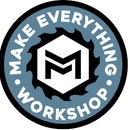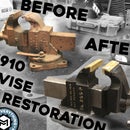Introduction: Making a Breakfast Nook (W/ Storage) & Kitchen Table
In this instructable I build a simple breakfast nook and kitchen table out of 2x4s, 1x4s, and 3/4” Sanded plywood. This simple design can be easily scaled and made bigger or smaller to fit your space. I have made the google sketch file available for free on my website HERE.
If you want to watch a video with a. voiceover describing the build in detail check it out below. Otherwise, head into this insctuctables for a detailed write up! Got questions? Leave them in the comments!
Step 1: Planning and Cut List
This build was for a client that wanted something she found photos of online but wanted specific to fit her space. For jobs like this I like to do a google sketch model so the customer knows exactly what they are getting and what it will look like. It also makes it easy to make a perfect cut list based on the dimensions of the model.
Step 2: Building the Frames
I use Burell 2x4s from home depot for the frames of the bench seats. The design is very simple, 2 rectangular frames with posts at each corner. Everything is screwed and glued with 3” screws and titebond wood glue. I check to be sure everything is parallel and square as I go.
Step 3: Checking the Layout
One the frames are built I do a quick assembly of them, check the seating height and the dimensions to know I'm on the right track
Step 4: Cutting the Plywood Sides
The design allows for 3/4” plywood to cover 2 sides of each frame, I chose not to cover the back to keep the weight and cost of the project down. It will sit tight against a wall so there was no reason to cover those unexposed sides. I refer back to my cut list for the exact lengths and widths I need.
Step 5: Cover the Sides
I used a Milwaukee “drywall” gun on a lot of my projects that involve plywood and 2x4. Its a great fast way to attach wood to wood. I make sure everything is lined up properly and use a liberal amount of screws to keep it strong.
Step 6: Trim Out the Benches
Using 1 x 4 #1 pine I add a decorative trim around the boarders of the benches. This project will be stained by the client so I am very careful to keep all my seams and gaps tight. Normally if your painting you can be a little loose with you corners and fill up later but with stain I've found that no wood filler really does a great job of accepting stain, and keeping things tight works best for a clean finished product. I use a 23ga pin nailer to nail from the front, and screws to screw the trim in from the back ( wherever I can). This plus the glue makes for a really tightly trimmed project.
On the corners I chose to miter the material the long way and build nice tight corner blocks for a consistent dimension around all sides.
Step 7: Add Some Supports
With the outside of the benches finished I decided it would be a good idea to add some 2x4 supports to the front and back of the benches at the long sides. These are screwed and glued in to keep the bench from sagging under weight over time.
Step 8: Closing the Tops
These benches will have doors cut in them for storage but before we get to that point we have to close up the tops. I use glue and screws in the drywall gun to close it up tight. This will also keep them very stable.
Step 9: Cutting the Storage Doors
My method for cutting doors into a project like this is to lay out the doors, cut them 90% of the way around, add the hinges, and complete the cuts. Ive found this is the most efficient way to add doors. With the door panel still secured by the remaining wood the hinges install very quickly, and then once you free the door up by completing the cuts they work flawlessly. I also add a little material under the bench tops to act as door stops to the doors down ver sag under the level of the bench seat.
Step 10: Add Assembly Registration Marks
This piece will be picked up by the client and installed by them no their own. Because of this I make sure to make the seams between the two benches with sharpie and make it very easy to know what goes where during reassembly. Even if you making this piece for yourself its always good practice to make your material in a place that nobody will see but you. My projects are always covered in marks and notes that nobody else will see ( or even understand), but they help tremendously!
Step 11: Cut Up the Material for the Table
The table design is very simple and made almost entirely out of plywood. For the top Im using 2 pieces of 3/4” plywood thats glued and screwed together to make one solid 1.5” thick top. For the single leg I am building a column using 3/4” plywood thats mitered on the l one sides and glued and nailed together. I rip up this material on the table saw, and cut it to length on the miter saw.
Step 12: Glue Up the Table Top
This method of making a table top works very well to get a stable and solid piece of 1.5” material quickly. We apply a liberal coat of wood glue and then about 50 1 1/4” drywall screws acting as clamps to the two pieces of wood. I let this piece dry overnight before I cut the table top down to its final size ( in this case 47” x 47”)
Step 13: Assemble the Table Leg Column
The column is a pretty simple assembly. With the 4 pieces mitered and cut to the same length I use glue and a 23 gauge pin nailer to assemble at the corners. Here is a tip when assembling boxes/ columns like this. Its almost unavoidable to have a slight gap in your corner edges when doing this type of work. My solution is to use a hmmer head or handle to smooth over the edges and round them into one another. I then use a sander and blend the corners until they look seamless. This trick works very well to get a near perfect finish on your outside corners, even if you have a relatively large gap!
Step 14: Build the Base and Mounting Brackets
The base for this table is basically just a smaller version of the table top. I make a 24 x 24” plate using 2 pieces of 3/4” plywood, glue and screws.
For the mounting brackets I use a 2x4 ripped in half and build 2 small squares. These squares are then glued and screws to both the base and the table top, they perfectly fit inside the column.
Step 15: Assemble the Table
With the Top and base complete and the square brackets installed it fits together like legos! Just slide the column over the base, and add some screws. then add the top and install some more screws. Since the stain the client is using is dark I chose to use more black drywall screws, these will disappear once its stained.
Step 16: Edgeband the Table Top
For the edge of the table top I didn't want the plywood to be exposed. I took a piece of 1x4 and ripped it in half, then cut miters on the corners to wrap the table top edges. I used glue and the pin nailer to set it in place.
Step 17: SANDING!
At this point the project is done! I sanded the whole top to 220 grit and did a test assembly to see how it looked on the table!
Step 18: The Finished Product!
As I said earlier the client decided to finish this piece on their own with a walnut stain from minwax. I think it came out really well and they are really happy with the way it looks in their kitchen. Their next plans are to upholster cushions for the bench seats. I hope this project contained information that was helpful and I hope it inspired you to make you own breakfast nook! If you like this predict please vote for it in the Furniture contest here on instructables. and if you like the video please share, like and subscribe to my channel for more!
Also if your local to the NYC area I teach classes at Make Everything, check out the website for more info!
Thanks!

Second Prize in the
Furniture Contest 2017













